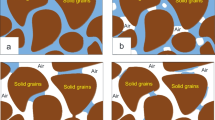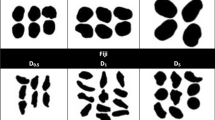Abstract
To study the shear behaviour of foam-conditioned muck with high fluidity in an earth pressure balance (EPB) shield, a new triaxial apparatus was developed. The newly developed triaxial apparatus are aimed at addressing the issue of specimen preparation for soils with high fluidity, which is not possible in a conventional triaxial apparatus. This is achieved by equipping the triaxial cell with a detachable mesh-shaped cylindrical mould, through which the initial confining water pressure is able to be exerted directly on the soil specimen so that it is able to remain upright with the prescribed size. Dry sands were used to conduct triaxial tests in a conventional triaxial apparatus and the newly developed triaxial apparatus. The testing results of the stress–strain curves and shear strengths of the specimens measured with the newly developed apparatus agree well with those measured with the traditional triaxial apparatus, verifying the reliability of the new triaxial apparatus. Triaxial tests using the new apparatus were then implemented with foam-conditioned shield muck. The testing results showed that the muck exhibited strain hardening with a water content of 45% and a foam injection ratio (the ratio of foam volume to muck volume) of 40%; the internal friction angle was measured to be approximately 0°, and the cohesion was measured to be 0.55 kPa. Interestingly, a shear contraction phenomenon was observed in the foam-conditioned gravelly clay muck under different confining pressures. The newly developed device provides an effective test vehicle for the study of the shear behaviour of foam-conditioned shield muck.













Similar content being viewed by others
Data availability
The data used during the current study are available from the corresponding author on reasonable request.
References
Bayat E, Bayat M (2012) Effect of grading characteristics on the undrained shear strength of sand: review with new evidences. Arab J Geosci 6(11):4409–4418. https://doi.org/10.1007/s12517-012-0670-y
Budach C, Thewes M (2015) Application ranges of EPB shields in coarse ground based on laboratory research. Tunn Undergr Space Technol 50:296–304. https://doi.org/10.1016/j.tust.2015.08.006
Cai H, Wei R, Xiao JZ, Wang ZW, Yan J, Wu SF, Sun LM (2020) Direct shear test on coarse gap-graded fill: plate opening size and its effect on measured shear strength. Adv Civ Eng 2020:1-13. Artn 5750438 https://doi.org/10.1155/2020/5750438
Castelli F, Cavallaro A, Grasso S, Lentini V (2019) Undrained cyclic laboratory behavior of sandy soils. Geosciences 9(12). ARTN 512 https://doi.org/10.3390/geosciences9120512
Dong Y, Wang YC, Lu LG, Wang W (2013) The improved shear strength calculation method in direct shear test. Prog Indust Civil Eng Ii, Pts 1-4, 405-408, 353-357. https://doi.org/10.4028/www.scientific.net/AMM.405-408.353
EFNARC A (2005) Specifications and Guidelines for the use of specialist products for Mechanized Tunnelling (TBM) in Soft Ground and Hard Rock. Recommendation of European Federation of Producers and Contractors of Specialist Products for Structures
Gatto MPA, Lentini V, Montrasio L (2022) Dynamic properties of polyurethane from resonant column tests for numerical GSI study. Bull Earthq Eng. https://doi.org/10.1007/s10518-022-01412-0
GB/T 50123 (2019) Standard for soil test method (2019). China Planning Press. (In Chinese)
GB/T 50145 (2007) Standard for engineering classification of soil (2008). China Planning Press: Beijing, China. (In Chinese)
Hanna A (2001) Determination of plane-strain shear strength of sand from the results of triaxial tests. Can Geotech J 38(6):1231–1240. https://doi.org/10.1139/cgj-38-6-1231
He CB, You Y, Wang DC, Wu HJ (2018) Estimating soil failure due to torsion via vane shear test by varying vane diameter and soil properties. Soil Tillage Res 177:68–78. https://doi.org/10.1016/j.still.2017.12.004
Huang S, Wang SY, Xu CJ, Shi YF, Ye F (2019) Effect of grain gradation on the permeability characteristics of coarse-grained soil conditioned with foam for EPB shield tunneling. KSCE J Civ Eng 23(11):4662–4674. https://doi.org/10.1007/s12205-019-0717-7
Lee H, Kwak J, Choi J, Hwang B, Choi H (2022) A lab-scale experimental approach to evaluate rheological properties of foam-conditioned soil for EPB shield tunnelling. Tunn Undergr Space Technol 128:104667. https://doi.org/10.1016/j.tust.2022.104667
Ling FL, Wang SY, Hu QX, Huang S, Feng ZY (2021) Effect of bentonite slurry on the function of foam for changing the permeability characteristics of sand under high hydraulic gradients. Can Geotech J. https://doi.org/10.1139/cgj-2021-0196
Liu PF, Wang SY, Ge L, Thewes M, Yang JS, Xia YM (2018) Changes of Atterberg limits and electrochemical behaviors of clays with dispersants as conditioning agents for EPB shield tunnelling. Tunn Undergr Space Technol 73:244–251. https://doi.org/10.1016/j.tust.2017.12.026
Liu ZC, Dai S, Ning FL, Peng L, Wei HZ, Wei CF (2018) Strength estimation for hydrate-bearing sediments from direct shear tests of hydrate-bearing sand and silt. Geophys Res Lett 45(2):715–723. https://doi.org/10.1002/2017gl076374
Liu XY, Fang HY, Wang FM, Yuan DJ (2021) Horizontal trap-door investigation on face failure zone of shield tunneling in sands. J Cent South Univ 28(3):866–881. https://doi.org/10.1007/s11771-021-4632-y
Martinelli D, Todaro C, Luciani A, Peila D (2019) Use of a large triaxial cell for testing conditioned soil for EPBS tunnelling. Tunn Undergr Space Technol 94. ARTN 103126 https://doi.org/10.1016/j.tust.2019.103126
Meng FY, Chen RP, Mooney M A, Wu HN, Jia Q (2022) Evaluation of shield tunneling-induced soil disturbance in typical structured clays. Bullet Eng Geol Environ 81(4). https://doi.org/10.1007/s10064-022-02625-y
Mori L, Mooney M, Cha MS (2018) Characterizing the influence of stress on foam conditioned sand for EPB tunneling. Tunn Undergr Space Technol 71:454–465. https://doi.org/10.1016/j.tust.2017.09.018
Pan QJ, Dias D (2018) Three dimensional face stability of a tunnel in weak rock masses subjected to seepage forces. Tunn Undergr Space Technol 71:555–566. https://doi.org/10.1016/j.tust.2017.11.003
Presti DL, Pallara O, Cavallaro A, Jamiolkowski M (1999) Influence of reconsolidation techniques and strain rate on the stiffness of undisturbed clays from triaxial tests. Geotech Test J 22(3):211–225. https://doi.org/10.1520/GTJ11112J
Ren XH, Zhang Z, Shan YX (2015) Research of quantitative assessment methods on mechanical similarity of rock similar material. J China Univ Petroleum (Edition of Natural Science) 39(05):137–143. (In Chinese)
Wang SY, Hu QX, Wang HB, Thewes M, Ge L, Yang JS, Liu PF (2021) Permeability characteristics of poorly graded sand conditioned with foam in different conditioning states. J Test Eval 49(5):3620–3636. https://doi.org/10.1520/Jte20190539
Wang SY, Liu PF, Hu QX, Zhong JZ (2020) Effect of dispersant on the tangential adhesion strength between clay and metal for EPB shield tunnelling. Tunn Undergr Space Technol 95:103144. ARTN 103144 https://doi.org/10.1016/j.tust.2019.103144
Wang HB, Wang SY, Zhong JZ, Qu TM, Liu ZR, Xu T, Liu PF (2021a) Undrained compressibility characteristics and pore pressure calculation model of foam-conditioned sand. Tunn Undergr Space Technol 118. ARTN 104161 https://doi.org/10.1016/j.tust.2021.104161
Wang SY, Liu PF, Gong ZY, Yang P (2022a) Auxiliary air pressure balance mode for EPB shield tunneling in water-rich gravelly sand strata: feasibility and soil conditioning. Case Stud Constr Mater 16:e00799. https://doi.org/10.1016/j.cscm.2021.e00799
Wang SY, Ni ZL, Qu TM, Wang HB, Pan QJ (2022b) A novel index to evaluate the workability of conditioned coarse-grained soil for EPB shield tunnelling. J Constr Eng Manage 148(6):04022028. Artn 04022028 https://doi.org/10.1061/(Asce)Co.1943-7862.0002287
Wei YJ, Yang YY, Tao MJ, Wang DL, Jie YX (2020) Earth pressure balance shield tunneling in sandy gravel deposits: a case study of application of soil conditioning. Bull Eng Geol Env 79(9):5013–5030. https://doi.org/10.1007/s10064-020-01856-1
Wu YL, Mooney MA, Cha MS (2018) An experimental examination of foam stability under pressure for EPB TBM tunneling. Tunn Undergr Space Technol 77:80–93. https://doi.org/10.1016/j.tust.2018.02.011
Xiao C, Yang JS, Wang SY, He J, Ye XY (2016) Conditioned soils mechanical behavior of earth pressure balance shield tunneling and its impact on formation response. J Central South Univ (Science and Technology) 47(07):2432–2440. (In Chinese)
Xu QW, Zhang LY, Zhu HH, Gong ZY, Liu JG, Zhu YH (2020) Laboratory tests on conditioning the sandy cobble soil for EPB shield tunnelling and its field application. Tunn Undergr Space Technol 105. ARTN 103512 https://doi.org/10.1016/j.tust.2020.103512
Yao QY, Ji C, He C, Zhou SH (2021) A hybrid experiment/theory method for soil conditioning in sandy cobble strata with large cobbles and boulders. Bull Eng Geol Env 80(10):8189–8209. https://doi.org/10.1007/s10064-021-02418-9
Funding
The authors would like to thank the financial supports from the National Natural Science Foundation of China (Grant Nos. 52022112 and 52108388) and the Fundamental Research Funds for the Central Universities of Central South University (Grant No. 2021zzts0240).
Author information
Authors and Affiliations
Corresponding author
Ethics declarations
Conflict of interests
The authors declare no competing interests.
Rights and permissions
Springer Nature or its licensor (e.g. a society or other partner) holds exclusive rights to this article under a publishing agreement with the author(s) or other rightsholder(s); author self-archiving of the accepted manuscript version of this article is solely governed by the terms of such publishing agreement and applicable law.
About this article
Cite this article
Ni, Z., Wang, S., Pan, Q. et al. A new triaxial apparatus for high-fluidity shield muck: validation and application. Bull Eng Geol Environ 82, 188 (2023). https://doi.org/10.1007/s10064-023-03177-5
Received:
Accepted:
Published:
DOI: https://doi.org/10.1007/s10064-023-03177-5




